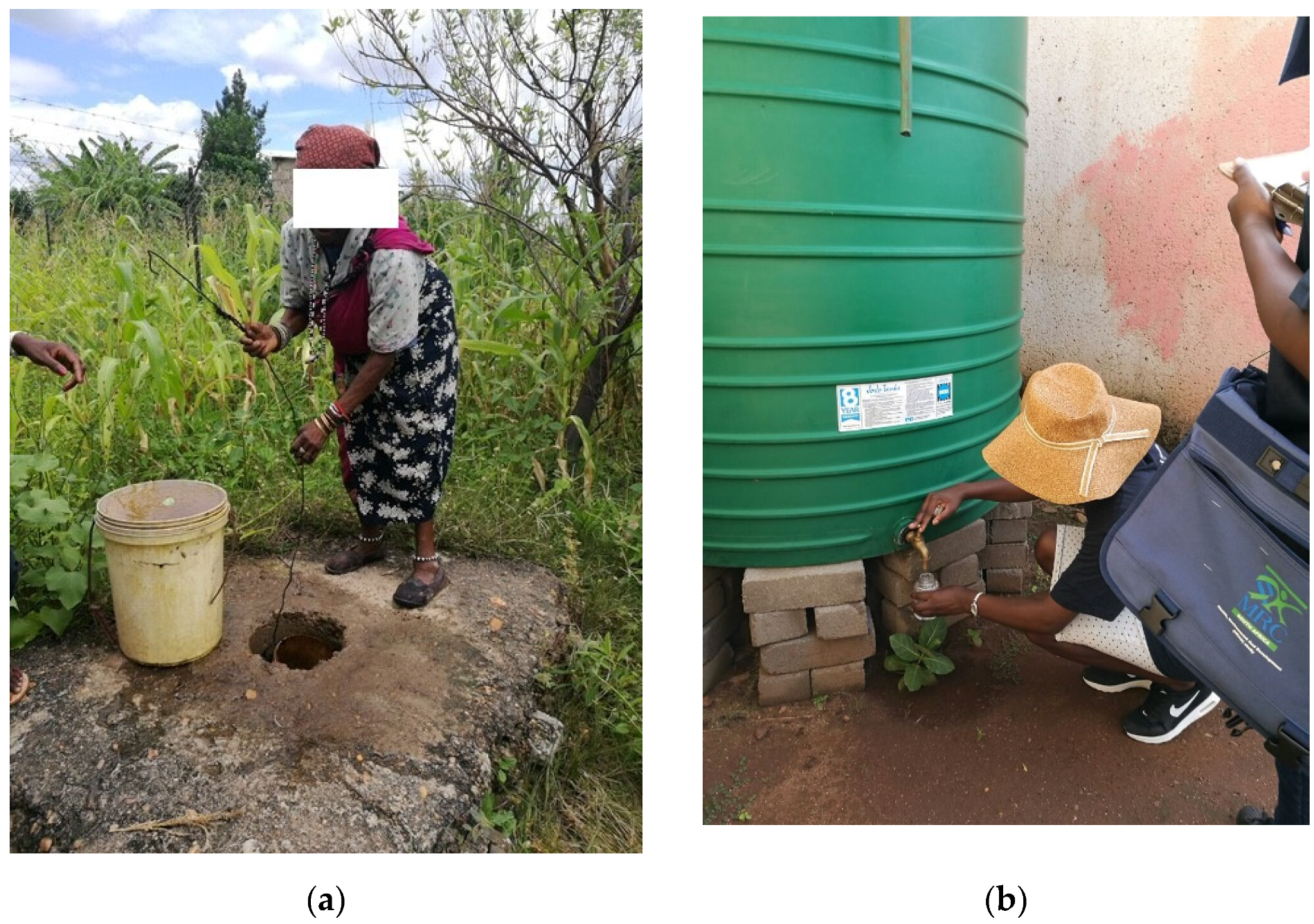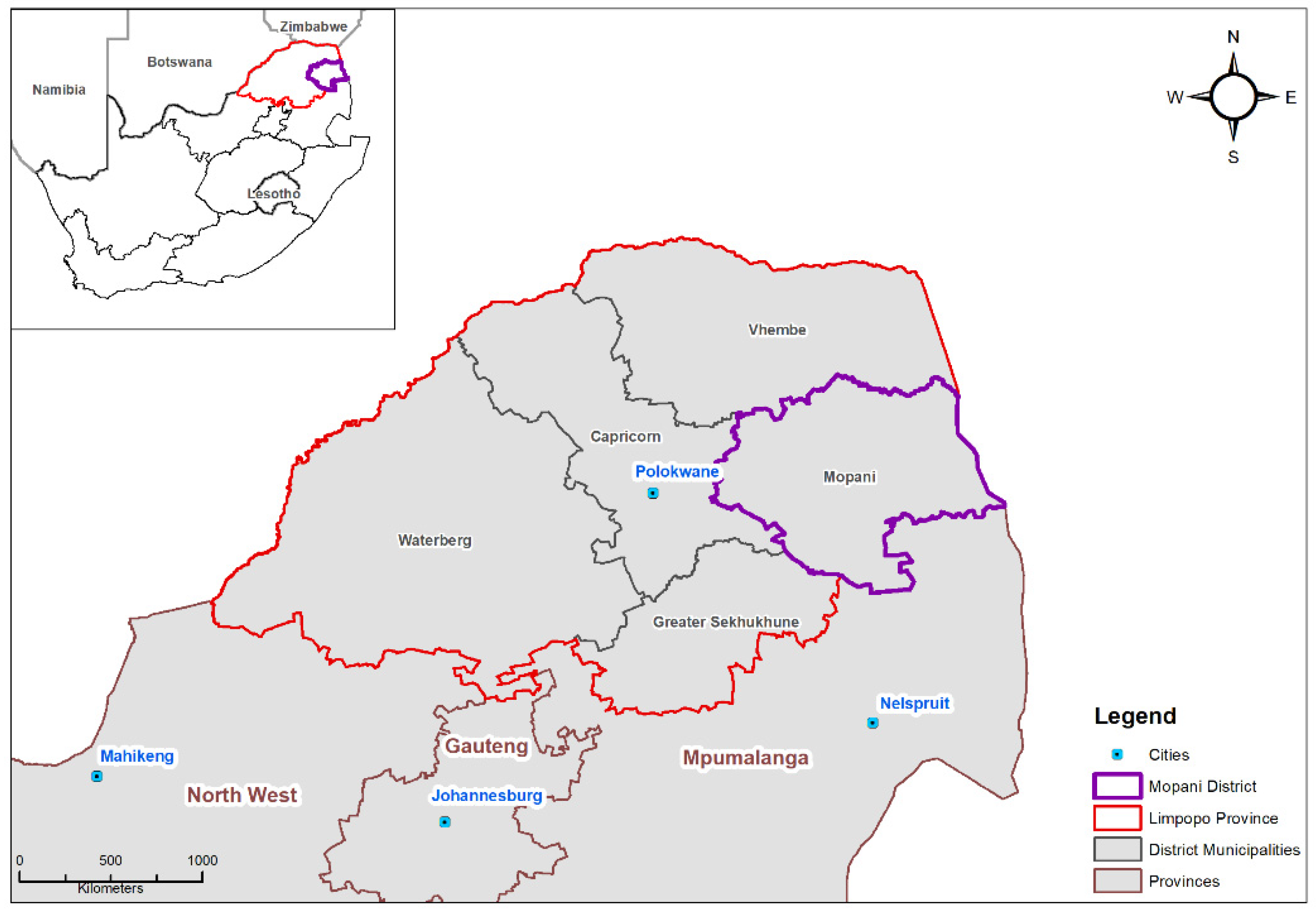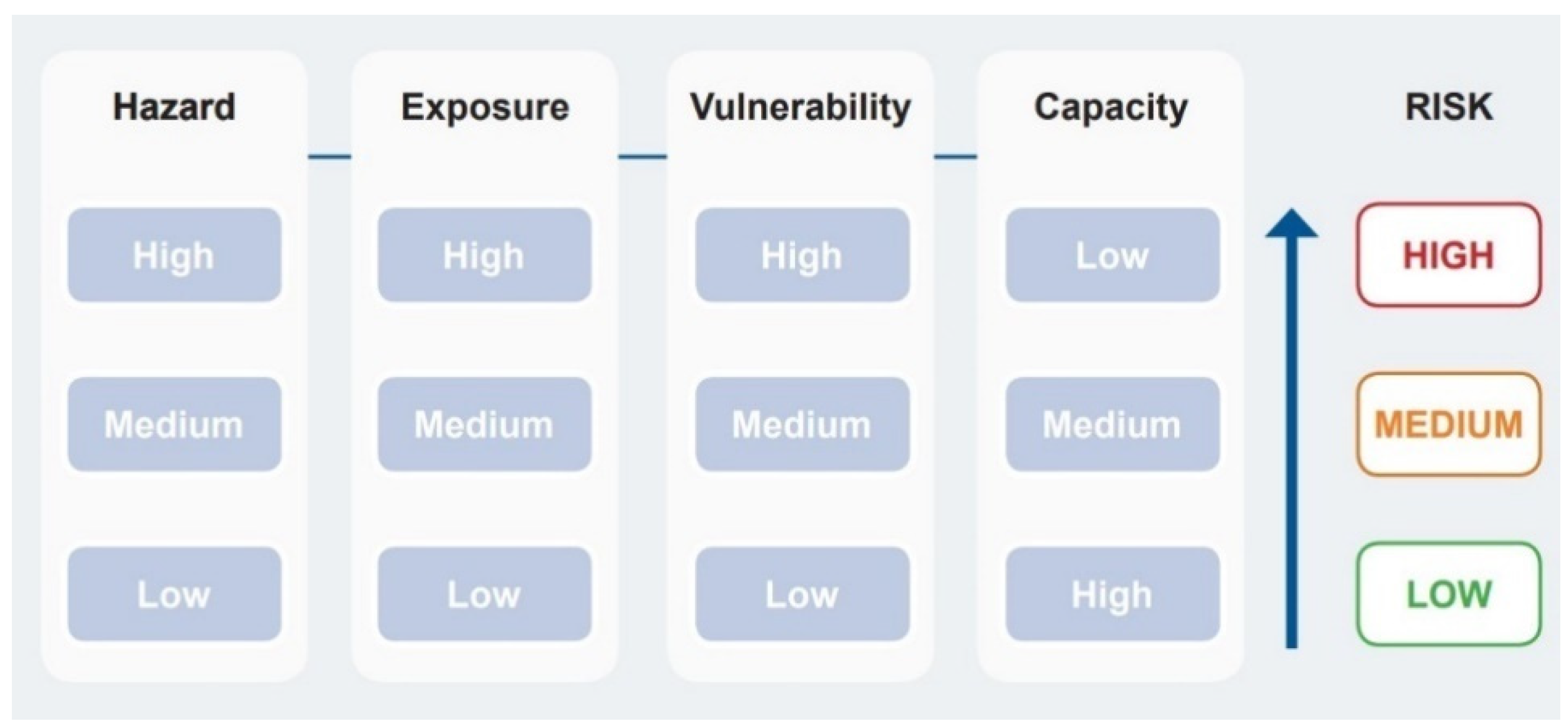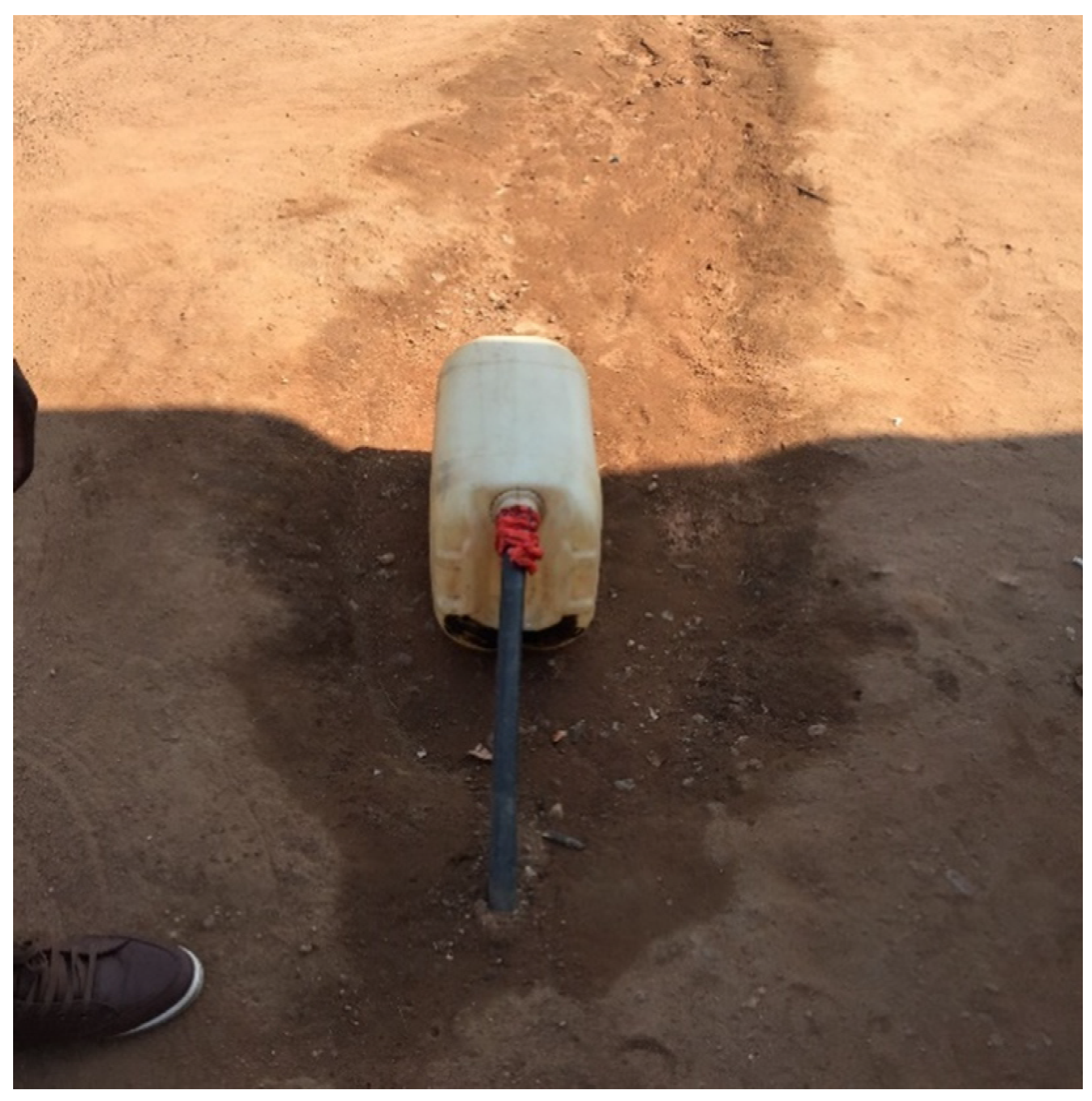Applying a WASH Risk Assessment Tool in a Rural South African Setting to Identify Risks and Opportunities for Climate Resilient Communities
Abstract
:1. Introduction
2. Materials and Methods
2.1. Study Area
2.2. Study Design
2.3. Patient Data
2.4. Risk Assessment Approach
2.4.1. Hazard Scoring
2.4.2. Exposure Scoring
2.4.3. Vulnerability Scoring
2.4.4. Risk Summary
3. Results and Discussion
3.1. Hazards/Threats Classification
3.2. Exposure Scoring
3.3. Vulnerability Scoring
3.4. Study limitations
4. Managerial Insights
5. Conclusions
Author Contributions
Funding
Institutional Review Board Statement
Informed Consent Statement
Data Availability Statement
Acknowledgments
Conflicts of Interest
References
- Bartram, J.; Hunter, P. Bradley Classification of disease transmission routes for water-related hazards. In Routledge Handbook of Water and Health; Routledge Handbooks Online; Routledge: Oxfordshire, UK, 2015; Available online: https://www.routledgehandbooks.com/doi/10.4324/9781315693606.ch03 (accessed on 30 January 2022).
- Prüss-Ustün, A.; Bartram, J.; Clasen, T.; Colford, J.M.; Cumming, O.; Curtis, V.; Bonjour, S.; Dangour, A.D.; De France, J.; Fewtrell, L. Burden of disease from inadequate water, sanitation and hygiene in low-and middle-income settings: A retrospective analysis of data from 145 countries. Trop. Med. Int. Health 2014, 19, 894–905. [Google Scholar] [CrossRef] [PubMed] [Green Version]
- World Health Organization. World Health Organisation Guideline on Sanitation and Health; World Health Organization: Geneva, Switzerland, 2018; Available online: https://www.who.int/publications/i/item/9789241514705 (accessed on 22 November 2021).
- Prüss-Ustün, A.; Wolf, J.; Batram, J.; Clasen, T.; Cumming, O.; Freeman, M.C.; Gordon, B.; Hunter, P.R.; Medlicott, K.; Johnston, R. Burden of disease from inadequate water, sanitation and hygiene for selected adverse health outcomes: An updated analysis with a focus on low-and middle-income countries. Int. J. Hyg. Environ. Health 2019, 222, 765–777. [Google Scholar] [CrossRef] [PubMed]
- Bamford, L.J.; McKerrow, N.H.; Barron, P.; Aung, Y. Child mortality in South Africa: Fewer deaths, but better data are needed. S. Afr. Med. J. 2018, 108, S25–S32. [Google Scholar] [CrossRef] [Green Version]
- Kapwata, T.; Mathee, A.; Le Roux, W.J.; Wright, C.Y. Diarrhoeal disease in relation to possible household risk factors in South African villages. Int. J. Environ. Res. Public Health 2018, 15, 1665. [Google Scholar] [CrossRef] [Green Version]
- Abrams, A.L.; Carden, K.; Teta, C.; Wågsæther, K. Water, Sanitation, and Hygiene Vulnerability among Rural Areas and Small Towns in South Africa: Exploring the Role of Climate Change, Marginalization, and Inequality. Water 2021, 13, 2810. [Google Scholar] [CrossRef]
- Engelbrecht, F.; Adegoke, J.; Bopape, M.-J.; Naidoo, M.; Garland, R.; Thatcher, M.; McGregor, J.; Katzfey, J.; Werner, M.; Ichoku, C.; et al. Projections of rapidly rising surface temperatures over Africa under low mitigation. Environ. Res. Lett. 2015, 10, 085004. [Google Scholar] [CrossRef]
- Chikwiramakomo, L.; Gumindoga, W.; Shekede, M.D.; Gara, T.W.; Chuma, T. Modelling flood hazard in dry climates of southern Africa: A case of Beitbridge, Limpopo Basin, Zimbabwe. Water SA 2021, 47, 488–497. [Google Scholar] [CrossRef]
- Howard, G.; Calow, R.; Macdonald, A.; Bartram, J. Climate Change and Water and Sanitation: Likely Impacts and Emerging Trends for Action. Ann. Rev. Environ. Res. 2016, 41, 253–276. [Google Scholar] [CrossRef] [Green Version]
- Howard, G.; Nijhawan, A.; Flint, A.; Baidya, M.; Pregnolato, M.; Ghimire, A.; Poudel, M.; Lo, E.; Sharma, S.; Mengusto, B. The how tough is WASH framework for assessing the climate resilience of water and sanitation. NPJ Clean Water 2021, 4, 39. [Google Scholar] [CrossRef]
- Ikeda, T.; Kapwata, T.; Behera, S.K.; Minakawa, N.; Hashizume, M.; Sweijd, N.; Mathee, A.; Wright, C.Y. Climatic factors in relation to diarrhoea hospital admissions in rural Limpopo, South Africa. Atmosphere 2019, 10, 522. [Google Scholar] [CrossRef] [Green Version]
- Department of Co-Operative Governance and Traditional Affairs. 33/52 Profile and Analysis, District Development Model; Mopani District Municipality Limpopo; Department of Co-Operative Governance and Traditional Affairs: Pietermaritzburg, South Africa, 2020. Available online: https://www.cogta.gov.za/ddm/wp-content/uploads/2020/11/Mopani-October-2020.pdf (accessed on 4 December 2021).
- Mopani District Municipality Demographic Information. Available online: https://municipalities.Co.Za/demographic/128/mopani-district-municipality (accessed on 14 December 2021).
- UNICEF. Global Water Partnership. WASH Climate Resilient Development; Guidance Note, Risk Assessment for WASH, United Nations Plaza; UNICEF: New York, NY, USA, 2017; ISBN 978-91-87823-39-8. Available online: https://www.gwp.org/globalassets/global/toolbox/publications/technical-briefs/gwp_unicef_guidance-note-risk-assessments-for-wash.pdf (accessed on 14 January 2022).
- World Health Organization. Microbial Fact Sheets. Available online: https://www.who.int/water_sanitation_health/publications/gdwq4-with-add1-chap11.pdf (accessed on 14 January 2022).
- Statistics South Africa. Census 2011 Statistical Release. Stats SA Library Cataloguing-in-Publication (CIP) Data Statistics South Africa; Statistics South Africa: Pretoria, South Africa, 2011. Available online: https://www.statssa.gov.za/publications/P03014/P030142011.pdf (accessed on 18 August 2021).
- Mopani District Municipality. Mopani District Municipality’s Integrated Development Plan 2021; Mopani District Municipality: Giyani, South Africa, 2021. Available online: http://www.mopani.gov.za/docs/idp/Mopani%20District%20IDP%202021%2022_2306.pdf (accessed on 6 August 2021).
- Intergovernmental Panel on Climate Change. IPCC Glossary of Terms 2021; Intergovernmental Panel on Climate Change: Geneva, Switzerland, 2021; Available online: https://www.ipcc-data.org/guidelines/pages/glossary/glossary_r.html (accessed on 18 August 2021).
- SADC. Special Report on Floods in Southern Africa 1999/2000 Issue 2; SADC: Gaborone, Botswana, 2000; Available online: https://reliefweb.int/report/botswana/sadc-special-report-floods-southern-africa-19992000-issue-2 (accessed on 31 January 2022).
- Mazibuko, S.; Mukwada, G.; Moeletsi, M. Assessing the frequency of drought/flood severity in the Luvuvhu River catchment, Limpopo Province, South Africa. Water SA 2021, 47, 172–184. [Google Scholar] [CrossRef]
- Botai, C.M.; Botai, J.O.; Zwane, N.N.; Hayombe, P.; Wamiti, E.K.; Makgoale, E.T.; Murambadoro, M.D.; Adeola, A.M.; Ncongwane, K.P.; De Wit, J.P. Hydroclimatic Extremes in the Limpopo River Basin, South Africa, under Changing Climate. Water 2020, 12, 3299. [Google Scholar] [CrossRef]
- Jimoh, M.Y.; Bikam, P.; Chikoore, H. The influence of socioeconomic factors on households’ vulnerability to climate change in semiarid towns of Mopani, South Africa. Climate 2021, 9, 13. [Google Scholar] [CrossRef]
- Khwashaba, M. Vulnerability and Resilience in the Mopani District Municipality in a Changing Climate; North-West University: Potchefstroom, South Africa, 2018; Available online: https://repository.nwu.ac.za/handle/10394/31259 (accessed on 26 January 2022).
- Makungo, R.; Odiyo, J.O. Groundwater quality and its distributions in Siloam Village, Limpopo Province, South Africa. WIT Trans. Ecol. Environ. 2018, 228, 35–44. Available online: https://www.witpress.com/elibrary/wit-transactions-on-ecology-and-the-environment/228/36626 (accessed on 18 August 2021).
- Sandton Chronicle. 90,000 Limpopo Residents Face Water Crisis Following Heatwave. Available online: https://sandtonchronicle.Co.Za/lnn/113128/90-000-limpopo-residents-face-water-crisis-following-heatwave (accessed on 13 July 2021).
- Asante, K.O.; Macuacua, R.D.; Artan, G.A.; Lietzow, R.W.; Verdin, J.P. Developing a flood monitoring system from remotely sensed data for the Limpopo basin. IEEE Trans. Geosci. Remote Sens. 2007, 45, 1709–1714. [Google Scholar] [CrossRef]
- Mulugisi, A. The Impacts of Heavy Rains on the Vegetation Cover in the Limpopo Province of South Africa; North-West University: Potchefstroom, South Africa, 2015; Available online: https://repository.nwu.ac.za/bitstream/handle/10394/17385/Mulugisi_A.pdf?sequence=1 (accessed on 26 January 2022).
- Adeola, A.; Ncongwane, K.; Abiodun, G.; Makgoale, T.; Rautenbach, H.; Botai, J.; Adisa, O.; Botai, C. Rainfall trends and malaria occurrences in Limpopo province, South Africa. Int. J. Environ. Res. Public Health 2019, 16, 5156. [Google Scholar] [CrossRef] [Green Version]
- Fitchett, J.; Hoogendoorn, G.; Swemmer, A. Economic costs of the 2012 floods on tourism in the Mopani District Municipality, South Africa. Trans. R. Soc. S. Afr. 2016, 71, 187–194. [Google Scholar] [CrossRef]
- Mosase, E.; Ahiablame, L. Rainfall and temperature in the Limpopo river basin, southern Africa: Means, variations, and trends from 1979 to 2013. Water 2018, 10, 364. [Google Scholar] [CrossRef] [Green Version]
- Makana, M. Drought Cripples Limpopo Farmers. Available online: https://www.Iol.Co.Za/news/south-africa/limpopo/drought-cripples-limpopo-farmers-1448228 (accessed on 13 July 2021).
- Nembilwi, N.; Chikoore, H.; Kori, E.; Munyai, R.B.; Manyanya, T.C. The occurrence of drought in mopani district municipality, South Africa: Impacts, vulnerability and adaptation. Climate 2021, 9, 61. [Google Scholar] [CrossRef]
- Nkgweng, T. Drought Leaves Limpopo’s Mopani District without Clean Water. SABC News. 3 July 2019. Available online: https://www.Sabcnews.Com/sabcnews/drought-leaves-limpopos-mopani-district-without-clean-water/ (accessed on 10 August 2021).
- Health Systems Trust. District Health Barometer 2015/2016; Health Systems Trust: Westville, South Africa, 2016; Available online: https://www.hst.org.za/publications/District%20Health%20Barometers/District%20Health%20Barometer%202015_16.pdf (accessed on 14 January 2022).
- World Health Organization. World Health Organization Guidelines for Drinking Water Quality 2017; World Health Organization: Geneva, Switzerland, 2017; Available online: https://www.who.int/publications/i/item/9789241549950 (accessed on 6 August 2021).
- South African Government. South African Water Quality Guidelines 1996; South African Government: Pretoria, South African, 1996. Available online: https://www.iwa-network.org/filemanager-uploads/WQ_Compendium/Database/Selected_guidelines/041.pdf (accessed on 6 August 2021).
- Johannessen, Å.; Rosemarin, A.; Thomalla, F.; Swartling, Å.G.; Stenstrom, T.A.; Vulturius, G. Strategies for building resilience to hazards in water, sanitation and hygiene (WASH) systems: The role of public private partnerships. Int. J. Dis. Risk Reduct. 2014, 10, 102–115. [Google Scholar] [CrossRef] [Green Version]
- Capone, D.; Berendes, D.; Cumming, O.; Holcomb, D.A.; Knee, J.; Konstantinidis, K.T.; Levy, K.; Nala, R.; Risk, B.B.; Brown, J. Impact of an Urban Sanitation Intervention on Enteric Pathogen Detection in Soils. Environ. Sci. Technol. 2021, 55, 9989–10000. [Google Scholar] [CrossRef]
- Kohlitz, J.P.; Chong, J.; Willetts, J. Climate change vulnerability and resilience of water, sanitation, and hygiene services: A theoretical perspective. J. Water Sanit. Hyg. Dev. 2017, 7, 181–195. [Google Scholar] [CrossRef]
- Yates, T.; Allen, J.; Leandre, J.M.; Lantage, D. WASH Interventions in Disease Outbreak Response; Oxfam: Oxford, UK, 2017; Available online: https://www.alnap.org/system/files/content/resource/files/main/wash-systematic-review.pdf (accessed on 18 August 2021).
- Taonameso, S.; Mudau, L.S.; Traore, A.N.; Potgieter, N. Borehole water: A potential health risk to rural communities in South Africa. Water Supply 2018, 19, 128–1236. [Google Scholar] [CrossRef] [Green Version]
- Statistics South Africa. Formal non-agricultural sector jobs increase in the 4th quarter 2020. South African Government, Pretoria. Available online: http://www/statssa.gov.za/?p14146 (accessed on 30 January 2022).
- Center for Disease Control. Heat Stress; In NIOSH; Center for Disease Control: Atlanta, GA, USA, 2018. Available online: https://www.cdc.gov/niosh/topics/heatstress/recommendations.html (accessed on 14 January 2022).
- Mopani District Municipality. Service Delivery Budget and Implementation Plan (SDBIP) for 2019–2020 for Mopani District; 2019. Available online: http://www.mopani.gov.za/docs/sdbip/Mopani%20Final%20%20%20District%20%20Municipality%20SDBIP%20June%2028.pdf (accessed on 10 August 2021).
- United Nations Sustainable Development Goals, Goal 6: Clean Water and Sanitation. 2018. Available online: https://www.unep.org/explore-topics/sustainable-development-goals/why-do-sustainable-development-goals-matter/goal-6 (accessed on 30 January 2022).
- United Nations. Sendai framework for disaster risk reduction 2015–2030. In Proceedings of the UN World Conference on Disaster Risk Reduction, Sendai, Japan, 14–18 March 2015; United Nations Office for Disaster Risk Reduction: Geneva, Switzerland, 2015. Available online: https://www.preventionweb.net/files/43291_sendaiframeworkfordrren.pdf (accessed on 30 January 2022).




| Bacterial Pathogen | Source of Exposure | Symptoms/Diseases | WASH Description |
|---|---|---|---|
| Burkholderia Cepacia | Hygiene | Lung infections | The germs spread either by direct contact, such as kissing, or indirectly from touching objects on which germs were situated, such as doorknobs. This is known as cross-infection and can happen in social settings such as events, gatherings, or meetings. |
| Enterococcus Faecalis | Hygiene | UTIs, prostatitis, intra-abdominal infection, cellulitis, wound infection | A strong association between hand hygiene method and bacterial contamination of hands has been found |
| Enterococcus Faecium | Hygiene | UTIs | A strong association between hand hygiene method and bacterial contamination of hands has been found |
| Enteropathogenic Escherichia Coli (EPEC) | Water, food, hygiene | diarrhea | In general, strategies for the prevention and control of the spread of EPEC should include access to safe water, good handling practices to reduce the risk of food contamination, sanitation measures, public education, and vaccination |
| Non-specific pathogenic Escherichia Coli | Water, food, hygiene | Diarrhea, UTIs, respiratory illness, pneumonia | Un-speciated E. coli may not be pathogenic but, given that the laboratory records state its presence, it may be taken to represent a pathogenic strain. |
| Salmonella Group | Water, food, and hygiene | Gastrointestinal illness | Some common ways in which a person can become infected with salmonella include: Eating food or drinking water that has been contaminated with animal faeces Eating food that has been handled by a food worker who has not properly washed their hands |
| Shigella Flexneri | Water, hygiene | Diarrhea | Swallowing recreational water (for example, lake or river water) while swimming or drinking water that is contaminated with stool (faeces) containing the germ. |
| Hazard/Threat | Present-Day Frequency and Intensity | Classification of Hazards |
|---|---|---|
| High temperature/heatwaves [21,22,23,24,25,26] |
| High: The Mopani District is well known for experiencing heatwaves and high temperature and adequate data exist to support this classification. |
| Heavy rains/flooding [27,28,29,30,31] |
| High: The Mopani District is well known for experiencing heavy rains and flooding and adequate data exist to support this classification. |
| Drier than usual/dry spells [12,32,33,34] |
| Medium: Existence of dry spells is evident but additional data for the Mopani District is needed to assign that this as high since drought also probably requires detailed consideration. |
| Variable | Frequency n | Frequency % |
|---|---|---|
| Number of laboratory samples by WASH-related organisms (n = 3 070) | ||
| Alcalgenes Faecalis Subsp faecalis | 12 | 0.4 |
| Burkholderia Cepacia | 19 | 0.6 |
| Enterococcus Faecalis | 642 | 21 |
| Enterococcus Faecium | 108 | 6 |
| Enteropathogenic Escherichia Coli | 1 | <1 |
| Escherichia Coli | 2241 | 73 |
| Salmonella Group | 34 | 1 |
| Shigella Flexneri | 9 | 0.3 |
| Shigella Group | 4 | 0.1 |
| Patient age | ||
| Under 5-year-olds | 308 | 10 |
| 5–18-year-olds | 335 | 11 |
| 19–65-year-olds | 2019 | 66 |
| Older than 65 years | 263 | 9 |
| Missing | 143 | 5 |
| Patient gender | ||
| Male | 923 | 30 |
| Female | 2124 | 69 |
| Missing | 23 | <1 |
| Human Indicator | Outcome for Mopani District | Classification of Exposure |
|---|---|---|
| Child health | Mopani District had the second highest number of deaths due to diarrhea nationally for children aged under 5 years of age (case fatality rate of 4%) [35]. | High: Above the national target of 3%. |
| Morbidity | In 2015, 15% of hospital admissions from two major hospitals in the district were diarrhea related [12]. | High: More than 15% of total admissions were due to a WASH-related illness. |
| From 2015 to 2018, among 20,250 laboratory specimens, there was a 5% prevalence of WASH-related bacterial pathogens (this study). | High: 5% of laboratory specimens were associated with a WASH-related bacterial pathogen. | |
| Water quality | Microbial water quality of water samples collected from Mopani standpipes had high microbial risk. Total coliform counts exceeded 100 counts/100 mL water in 29% of these samples. A similar pattern was observed for E.coli with more than 20 counts/100 mL detected in 11% of samples from standpipes [2,3,6]. | High: More than a third of households were exposed to microorganisms that can cause diseases and that may come via piped water provided by the municipality. |
| Factor | Element | Question | Outcome for Mopani District | Classification of Vulnerability |
| Environ-mental | Waste disposal | Is domestic waste collected and disposed of safely by municipal authorities? | Only 15% of population has refuse removed by authorities. 68% of population use their own refuse dump. | High: A large proportion of the population does not have access to formal domestic waste disposal. |
| Human | Age of population | Is there a large population of very old or young people? | 40% of the population is under the age of 18 years. | Medium: Close to 50% of the population is under the age of 18 years. |
| Socio-economic stability | What are the levels of employment? What are levels of income per month? # | 26% of population is employed; 50% are not economically active. 17% are unemployed. 43% of population do not earn any income; 45% earn less than ZAR 1600; 4% earn between ZAR 1600–3200; 2% earn between ZAR 3200–6400; 4% earn more than ZAR 6400. | High: There is low socio-economic stability in Mopani District. High percentages of the population do not earn any income or earn well below minimum wages. | |
| Physical | Technology of WASH physical infrastructure | Which latrine types are predominantly used? Are they resilient? | 69% of population in Mopani use pit latrines. These are often poorly designed and not designed to be resilient to climate shocks. | High: Poor/basic WASH infrastructure is available. Resilience of infrastructure is low due to poor design and construction of pit latrines. |
| What is the availability of water supply infrastructure? | 16% of population is without access to piped water. | High: The percentage of people without access to piped water from a tap in their home, yard or community is high (>80%). | ||
| Political and institutional | Climate change policies and adaptation plans for the water supply and sanitation sectors for Mopani district | Are there any government or municipal policies/legislature on climate change and adaptation plans for water supply and sanitation sectors? | Climate change policies and adaptation plans identify the risks to sanitation and drinking water, but sanitation policies do not discuss climate change or offer recommendations on adaptation. | High: The Mopani District Municipality Climate Change Vulnerability Assessment and Response Plan identifies sanitation as an impacted sector. Projections suggest increased risk of flooding and rainfall intensities, flash floods and regional flooding, litter and debris blocking water and sanitation systems. No sanitation policy was found. |
Publisher’s Note: MDPI stays neutral with regard to jurisdictional claims in published maps and institutional affiliations. |
© 2022 by the authors. Licensee MDPI, Basel, Switzerland. This article is an open access article distributed under the terms and conditions of the Creative Commons Attribution (CC BY) license (https://creativecommons.org/licenses/by/4.0/).
Share and Cite
Kapwata, T.; Kunene, Z.; Wernecke, B.; Lange, S.; Howard, G.; Nijhawan, A.; Wright, C.Y. Applying a WASH Risk Assessment Tool in a Rural South African Setting to Identify Risks and Opportunities for Climate Resilient Communities. Int. J. Environ. Res. Public Health 2022, 19, 2664. https://doi.org/10.3390/ijerph19052664
Kapwata T, Kunene Z, Wernecke B, Lange S, Howard G, Nijhawan A, Wright CY. Applying a WASH Risk Assessment Tool in a Rural South African Setting to Identify Risks and Opportunities for Climate Resilient Communities. International Journal of Environmental Research and Public Health. 2022; 19(5):2664. https://doi.org/10.3390/ijerph19052664
Chicago/Turabian StyleKapwata, Thandi, Zamantimande Kunene, Bianca Wernecke, Samantha Lange, Guy Howard, Anisha Nijhawan, and Caradee Y. Wright. 2022. "Applying a WASH Risk Assessment Tool in a Rural South African Setting to Identify Risks and Opportunities for Climate Resilient Communities" International Journal of Environmental Research and Public Health 19, no. 5: 2664. https://doi.org/10.3390/ijerph19052664
APA StyleKapwata, T., Kunene, Z., Wernecke, B., Lange, S., Howard, G., Nijhawan, A., & Wright, C. Y. (2022). Applying a WASH Risk Assessment Tool in a Rural South African Setting to Identify Risks and Opportunities for Climate Resilient Communities. International Journal of Environmental Research and Public Health, 19(5), 2664. https://doi.org/10.3390/ijerph19052664







